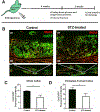Diabetes impairs periosteal progenitor regenerative potential
- PMID: 33221502
- PMCID: PMC7770068
- DOI: 10.1016/j.bone.2020.115764
Diabetes impairs periosteal progenitor regenerative potential
Abstract
Diabetics are at increased risk for fracture, and experience severely impaired skeletal healing characterized by delayed union or nonunion of the bone. The periosteum harbors osteochondral progenitors that can differentiate into chondrocytes and osteoblasts, and this connective tissue layer is required for efficient fracture healing. While bone marrow-derived stromal cells have been studied extensively in the context of diabetic skeletal repair and osteogenesis, the effect of diabetes on the periosteum and its ability to contribute to bone regeneration has not yet been explicitly evaluated. Within this study, we utilized an established murine model of type I diabetes to evaluate periosteal cell differentiation capacity, proliferation, and availability under the effect of a diabetic environment. Periosteal cells from diabetic mice were deficient in osteogenic differentiation ability in vitro, and diabetic mice had reduced periosteal populations of mesenchymal progenitors with a corresponding reduction in proliferation capacity following injury. Additionally, fracture callus mineralization and mature osteoblast activity during periosteum-mediated healing was impaired in diabetic mice compared to controls. We propose that the effect of diabetes on periosteal progenitors and their ability to aid in skeletal repair directly impairs fracture healing.
Keywords: Advanced glycation end products (AGEs); Diabetic fracture healing; Mesenchymal progenitors; Periosteum; Skeletal repair.
Copyright © 2020. Published by Elsevier Inc.
Conflict of interest statement
Declaration of Interests
The authors report no conflict of interest.
Figures





References
Publication types
MeSH terms
Grants and funding
LinkOut - more resources
Full Text Sources
Other Literature Sources

